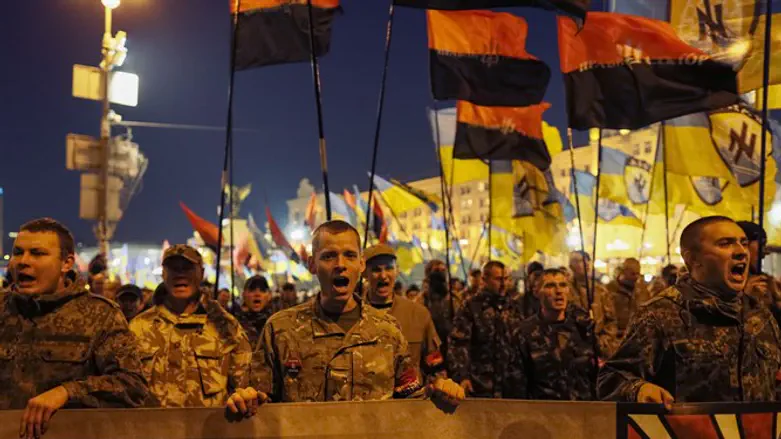
On the Sabbath day, February 15 1919, horror came to the Jewish community of the Ukrainian town of Proskurov. The Proskurov pogrom would come to signify the tragedy that befell the Jews of Ukraine during the Ukrainian-Soviet war. (1918-1920)
Following the withdrawal of German troops after World War One from Ukraine, Communist Bolshevik troops sought control as did Ukrainian nationalists. Also involved were the White Russians who wanted to restore Czarist rule.
Proskurov had no historical record of ever experiencing a pogrom despite its location in a terror plagued region that had suffered many violent attacks for hundreds of years. No pogrom since that of Kishinev in 1904 had made such an impact upon Jewry. The Pruskoruv pogrom caused great fear and panic which spread throughout towns in Ukraine in early 1919 and alarmed world Jewry to the dire emergency Ukrainian Jewry was facing.
In early 1919, Ukrainian nationalists unleashed their fury against the Jews. Massacres were perpetrated in Yekaterinoslav, Zhitomir and other cities in the Ukraine. Proskurov Jewry, which numbered about 25,000, was soon in great danger.
The local Haidamak (Cossack) leader Ataman Semosenko, of the third regiment, who had assumed command just days earlier, targeted the Jews. At a dinner celebrating his new command, he delivered a speech in which he accused the Jews of being the enemy of Ukraine and the Cossacks. Semosenko called for the elimination of the Jews in order to “save the Ukraine.”
He also evoked the common canard that the Jews were Bolshevik revolutionaries and thus adversaries of Ukrainian independence. The vast majority of Jews however, were not Bolsheviks and there were also some Jews who were supporters of Ukrainian independence. Furthermore, other ethnic groups also had members of the Bolshevik party. The vast majority of the Jews of Proskurov, as Shtetl Jews at the time, were not involved in political affairs.
Three days before the massacre, haidamaks paraded throughout the city on horses with rifles in hand. Their intentions were to intimidate the Jews.
The last day before the massacre, was Friday, the fourteenth day of the month of Adar Rishon. (The first month of Adar in a leap year) The Jews of Proskurov were preparing for the Sabbath.
That Shabbat was a sunny day in Proskurov. The Jews observed the Sabbath partaking in the Sabbath meal but there was a foreboding sense of fear.
The pogrom soon began. Hordes of Cossacks divided into smaller groups and began attacks against Jews in the streets and in their homes. The savagery had begun.
Knives, swords and bayonets were most often used but there were also reports of hand grenades being used as well as Jews rushed to cellars and attics to escape.
There are accounts of the slaughter.
According to one survivor, “They (Cossacks) were divided into groups of five to fifteen men and swarmed into the streets which were inhabited by Jews. Entering the homes, they drew their swords and began to cut down the inhabitants without regard to sex or age. ….Jews were dragged out of cellars and lofts and murdered. ”
Entire families were slain.

The cries and screams of those who were tortured whose body parts were mutilated rose to the heavens. Many children became cripples from severed limbs. One survivor, Haia Greenberg, a nurse later testified to the horrors, “The young girls repeatedly stabbed; the two month old baby with hand lacerations. The five- year old who had been pieced by spears. The elderly man who had been thrown out of a window by his beard. The 13 year old who became deaf because of his wounds. His brother, who received eleven wounds to his stomach and left for dead next to his slain mother, the paralyzed son of a Rabbi who was murdered in his bed; The two young children who were cast alive into a fire. “
One survivor, Haia Greenberg, a nurse later testified to the horrors, “The young girls repeatedly stabbed; the two month old baby with hand lacerations. The five- year old who had been pieced by spears. The elderly man who had been thrown out of a window by his beard. The 13 year old who became deaf because of his wounds. His brother, who received eleven wounds to his stomach and left for dead next to his slain mother, the paralyzed son of a Rabbi who was murdered in his bed; The two young children who were cast alive into a fire. “
Greenberg added, “I will never forget the reddened snow sleds filled with the hacked bodies going to a common pit in the cemetery.”
Some of the victims were forced to dig their own graves. The cries and screams of those who were tortured whose body parts were mutilated rose to the heavens. Many children became cripples from severed limbs.
Some saved Jews at great risk. Dr. S.N Polozov helped many wounded Jewish children he found in the street. He hid more than twenty Jews in his own home.
There are reports of a few Priests who were murdered as they attempted to stop the pogrom.
The massacre was carried out from two to five in the afternoon.
While estimates place the number of deaths at 1600, there are also estimates that place the casualty list as higher. These figures do not include those who sustained severe injury and were crippled for life.
The Jewish hospital and makeshift medical stations were full of the wounded. Victims were brought to the Jewish cemetery by peasants. Most were buried in mass graves.
The following day, the horrors continued. Haidamaks attacked the nearby town of Felstin, perpetrating another massacre where an estimated six hundred Jews were murdered.
One century later, the massacre on that Shabbat in Proskurov, which had become a symbol of that tragic era, should be remembered. May the memories of the many martyrs of that era be for a blessing.
Larry Domnitch is an educator and author who lives in Efrat.